

Stop shark finning. 10 Things You Can Do to Save the Ocean. 1.
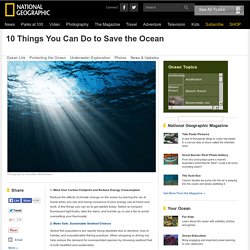
Mind Your Carbon Footprint and Reduce Energy Consumption Reduce the effects of climate change on the ocean by leaving the car at home when you can and being conscious of your energy use at home and work. A few things you can do to get started today: Switch to compact fluorescent light bulbs, take the stairs, and bundle up or use a fan to avoid oversetting your thermostat. 2. Make Safe, Sustainable Seafood Choices Global fish populations are rapidly being depleted due to demand, loss of habitat, and unsustainable fishing practices. 3. Plastics that end up as ocean debris contribute to habitat destruction and entangle and kill tens of thousands of marine animals each year. 4.
Threats to oceans and coasts. Ocean Pollution - Save Our Marine Life. What Do We Really Know About The Ocean Floor? 8 Ways You Are Harming The Ocean And Don't Even Know It. Every single living thing on Earth is connected to the ocean.
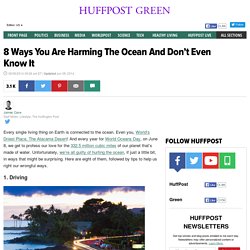
Even you, World’s Driest Place, The Atacama Desert! And every year for World Oceans Day, on June 8, we get to profess our love for the 332.5 million cubic miles of our planet that’s made of water. Unfortunately, we’re all guilty of hurting the ocean, if just a little bit, in ways that might be surprising. Here are eight of them, followed by tips to help us right our wrongful ways. Each time you drive, your car’s carbon emissions spread into the atmosphere and the oceans absorb a quarter of the world’s carbon dioxide emissions annually.
What you should do about it: Change your commute by biking or carpooling — or take inspiration from some of the most adventurous commuters ever. 2. Turns out there aren’t as many fish in the sea as the broken-hearted might hope. Aphotic zone Facts, information, pictures. Interesting Facts About the Aphotic (Midnight) Zone of the Ocean. Why The Ocean Can’t Fix The Drought. Should We Close The Ocean To Save Fish? How Much Trash Is In The Ocean? The Deep Sea - Exploring the Zones. Project Ocean - Can We Save Our Seas? What We Do: Protecting Our Oceans. Abyssal zone. Layers of the pelagic zone The abyssal zone is the abyssopelagic layer or pelagic zone that contains the very deep benthic communities near the bottom of oceans.
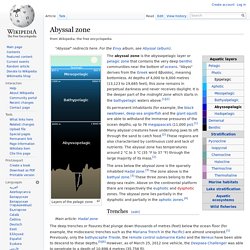
"Abyss" derives from the Greek word ἄβυσσος, meaning bottomless. At depths of 4,000 to 6,000 metres (13,123 to 19,685 feet), this zone remains in perpetual darkness and never receives daylight. Help Protect Our Ocean. Midnight Ocean (Aphotic) Zone. Advertisement.
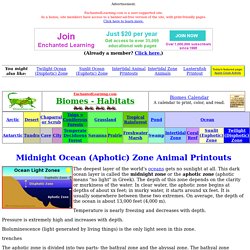
EnchantedLearning.com is a user-supported site. As a bonus, site members have access to a banner-ad-free version of the site, with print-friendly pages.Click here to learn more. (Already a member? Click here.) The Abyssopelagic Zone. Biology Project- The Abyssal Zone. Twilight Ocean (Disphotic) Zone. Advertisement.
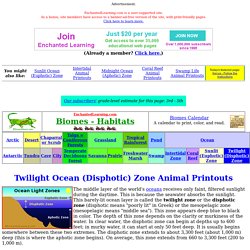
EnchantedLearning.com is a user-supported site. As a bonus, site members have access to a banner-ad-free version of the site, with print-friendly pages.Click here to learn more. (Already a member? Click here.) What animals live in the sunlight zone? How Much Trash Is In The Ocean? National Geographic. Sunlit Ocean (Euphotic) Zone. Advertisement.

EnchantedLearning.com is a user-supported site. As a bonus, site members have access to a banner-ad-free version of the site, with print-friendly pages.Click here to learn more. (Already a member? Diving Into the Twilight Zone. Understanding Ocean Zones: Sunlight Zone. Home > Ocean > Ocean Zones > Sunlight Zone Understanding Ocean Zones: The Sunlight Zone This ocean zone is from the surface of the sea down to a depth of about 200 meters.

As you begin your descent you see that the ocean is absolutely teeming with life forms of every sort. From the microscopic plankton and diatoms that give the ocean its murky color and limits visibility, to bony fishes of every shape and size, to starfishes, and warm-blooded, oxygen-breathing mammals. You can see the most fantastic array of colors; reds, pinks, purples, bright yellows, oranges, blues, greens.
Sunlit Ocean short movie. Five Reasons We are All Connected to Oceans. Peanut butter, every other breath you take, cancer medicine and one in six jobs in the United States.

What’s the connection? It’s not Kevin Bacon. But if you guessed our oceans: you’re right! You don’t need to live near the beach to be connected to the ocean. Oceans and coasts affect people’s lives every day, around the world. How much do oceans add to world’s oxygen? In April, 2013, NASA’s Aqua satellite captured this true-color image of the dynamic growth of a springtime phytoplankton bloom in the Bay of Biscay, off the coast of France.
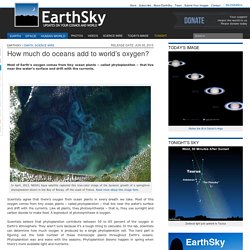
Read more about this image here. Scientists agree that there’s oxygen from ocean plants in every breath we take. Most of this oxygen comes from tiny ocean plants – called phytoplankton – that live near the water’s surface and drift with the currents. Like all plants, they photosynthesize – that is, they use sunlight and carbon dioxide to make food. A byproduct of photosynthesis is oxygen. Scientists believe that phytoplankton contribute between 50 to 85 percent of the oxygen in Earth’s atmosphere.
Why the Oceans matter. Deepest fish ever recorded in the Mariana Trench. Great White Sharks - Shark Pictures - Great White Facts. The legendary great white shark is far more fearsome in our imaginations than in reality.

As scientific research on these elusive predators increases, their image as mindless killing machines is beginning to fade. Hunting and Population Of the 100-plus annual shark attacks worldwide, fully one-third to one-half are attributable to great whites. However, most of these are not fatal, and new research finds that great whites, who are naturally curious, are "sample biting" then releasing their victims rather than preying on humans.
It's not a terribly comforting distinction, but it does indicate that humans are not actually on the great white's menu. Great whites are the largest predatory fish on Earth. They have slate-gray upper bodies to blend in with the rocky coastal sea floor, but get their name from their universally white underbellies. Found in cool, coastal waters throughout the world, there is no reliable data on the great white's population. Top ten biggest=heaviest marine Predators. Overfishing - excerpt from Planet Ocean the movie. What are ocean zones? Home > Ocean > Ocean Zones What are Ocean Zones? Welcome to the realm of the deep. We're talking deep that is so far down it's hard to fathom* (where do you think the expression came from?). Top 10 Facts - The Ocean. MONSTER BUG WARS: LIFE IN DEEP SEA TRENCHES.
OCEAN of TRUTH. Why the Ocean? Endangered sea creatures. Overfishing - Revolution World Issue. Ocean Photic Zones. Home - Plastic Oceans. Ocean zones. STOP OVERFISHING! Weird Creatures in Abyssal Zone. Time-Lapse: Bizarre, Beautiful Ocean Creatures. About Marine Life: Ocean Animals, Plants, and Habitats. Sea Change campaign: tackling ghost fishing gear. Our Sea Change campaign reduces the huge suffering caused by ‘ghost gear’ – abandoned fishing gear that turns oceans into death traps for sea animals The ghost fishing gear crisis Abandoned, lost and discarded nets, lines and traps are one of the biggest threats to our sea life.
A staggering 640,000 tonnes of gear is left in our oceans each year. That gear traps, injures, mutilates and kills hundreds of thousands of whales, seals, turtles and birds annually. So, through our Sea Change campaign, we’re aiming to save one million animals by 2018. By bringing together governments, businesses and fishing organisations, we can protect sea life and move towards a future free from the ghost fishing gear threat Ghost fishing gear: our work We’re working in three ways to protect animals from ghost fishing gear. Bring together partners to stop gear being abandoned Support new ways to remove ghost gear from the seas Help to replicate successful local sea animal rescue efforts on a global scale.
Rare life on the sea floor- The Abyss- BBC Wildlife. Layers of the Ocean - Deep Sea Creatures on Sea and Sky. Scientists have divided the ocean into five main layers. These layers, known as "zones", extend from the surface to the most extreme depths where light can no longer penetrate. These deep zones are where some of the most bizarre and fascinating creatures in the sea can be found. As we dive deeper into these largely unexplored places, the temperature drops and the pressure increases at an astounding rate. How Do We Solve Our Trash Problem? Pictures of the oceans zones. Our Debris Filling the Sea. What do a tropical island in the Pacific Ocean and the Antarctic have in common? Unfortunately, it’s marine debris. Even the most remote locations on Earth are fouled by man-made garbage and cast-outs. And a majority of the debris that’s found comes from land-based sources.
In one marine protected area off the Northwestern Hawaiian Islands, in just one month, 50 metric tons of debris was collected. That’s equivalent to 50 elephants worth of trash. And no matter what location it resides, it causes problems. There are no easy solutions to the worldwide problem of marine debris, but there are things you can do to help. We can recycle more, volunteer to clean up coastlines, and give support to programs that are tackling the issue in creative ways. Oceanic Layers and Zones. List of Oceans Animals. The Ocean We Want To Know - Animated Parody of Gotye's Somebody That I Used To Know. Exploring the Coral Reef: Learn about Oceans for Kids - FreeSchool. Ocean Light Zones. Why are oceans important? Abyssal zone.